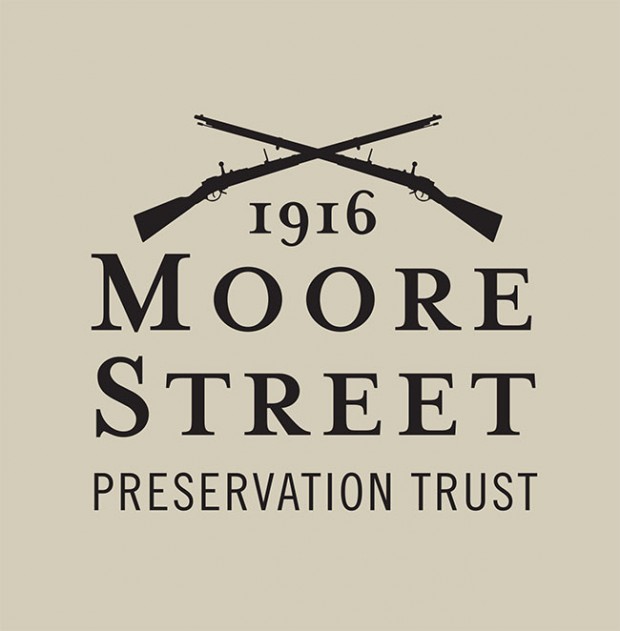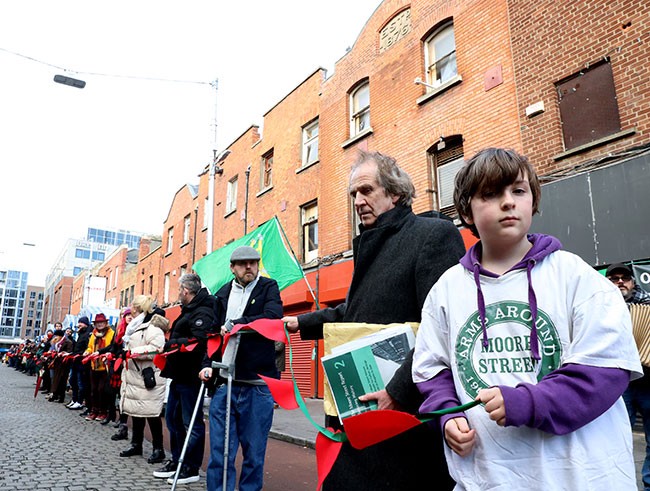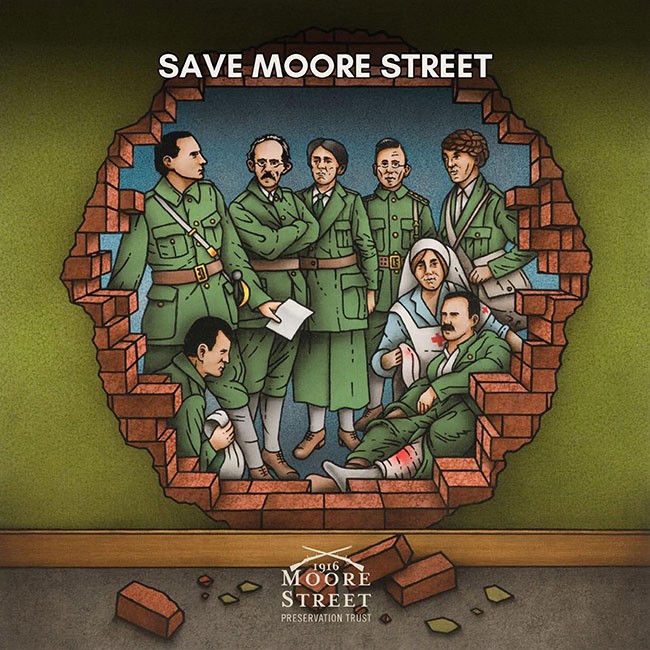30 November 2023 Edition
Moore Street is the great survivor of the 1916 Rising

The Moore Street Preservation Trust recently marked the 23rd anniversary of the campaign to save the historic buildings on this street with the unveiling of a depiction of the final meeting of the Provisional Government in 16 Moore Street by Robert Ballagh. Here, we carry an edited version of the speech made by James Connolly Heron at the launch.
• — • — • — • — • — •
23 years ago, ‘The Save Moore Street Campaign’ led by 1916 relatives called for state intervention to protect and preserve the last extant 1916 battleground from the developers wrecking ball.
23 years on, we still require state intervention to ensure that an area described by the National Museum of Ireland as the most important historic site in modern Irish history is protected and held in trust for future generations.
The state, through its purchase of 14 to 17 Moore Street, has recognised the importance of Moore Street in our history. 14 to 17 will house the 1916 Commemoration Centre in honour of a golden generation of our people who, at great cost and for no monetary gain or reward, fought in the cause of Irish freedom – the freedom we enjoy today.
Yet the terrace of buildings that became their last HQ was allowed fall into disgraceful decay and dereliction while successive administrations stood idly by waiting for a private property developer to produce a plan for Dublin Central that would gain the support of all interested parties.
The Hammerson plan does not have that required support. The latest plan does not meet the agreed recommendations of the Advisory Group to the Minister.

• Moore Street Preservation Trust protest form a human chain of hearts the length of the street in the campaign to save the buildings associated with the 1916 Rising, February 2022
Despite this, City planners have now granted planning permission on two of three Hammerson planning applications to proceed with their destruction of this area described by The National Museum as ‘the most important historic site in modern Irish history’.
In doing so, planners ignored the call by councillors as the elected representatives of the people for the listing of the terrace of buildings that became the last HQ of the 1916 Provisional Government. They did so before crucial survey reports on the buildings were finalised for consideration. They did so in face of opposition from the Department of Housing and Heritage that called for a redesign of the Hammerson plan.
They did so contrary to the recommendations of their own Moore Street Advisory Committee and The Lanes of History Report of the Lord Mayor’s Forum.
City planners have failed to act in the public interest in granting consent to those applications. Hardly a surprise. After all, city planners in the past granted consent to a previous application that would have seen this sacred ground reduced to rubble and transformed into a ‘park in the sky’ shopping centre. Were it not for the efforts of campaigners, Dublin Central would today be the location of an unfinished shopping mall.
These latest consents are now under appeal to An Bord Pleanála. The developers claim that their plan will sensitively rejuvenate this historic part of the city is simply untrue.
It will do nothing of the sort. It will redraw streets and lanes that have remained intact for over a century. It will take a wrecking ball to an area that predates the Rising. A street that predates the Famine and survived the disgraceful blitzing of our capital city in 1916 by enemy forces with incendiary shellfire. Moore Street is the great survivor of the Rising, the location of the last HQ of the 1916 Provisional Government still standing today.
In an extraordinary development, the developer who claimed to be aware and respectful of the historic importance of this last extant 1916 battleground has now issued legal proceedings against the council seeking to overturn the decision of the elected members to protect and preserve the 1916 terrace through the listing process.
This shows a breathtaking disregard for our history and heritage and flies in the face of the democratic wishes of the representatives of the people – our city councillors who rightly demand that the surviving terrace of houses remains intact in shape and form.
This is a modest demand. Lord Mayor, councillors, and city management must stand together and resist this challenge to their authority as guardians of our city its history and heritage. The Hammerson plan to redraw streets and laneways under the ownership of the City Council and interfere with and demolish buildings and structures within an area described by the National Museum of Ireland as “the most important historic site in modern Irish history” does not meet the agreed recommendations of the Advisory Group to Minister Darragh O’Brien, the position of the City Council or the objectives of the Dublin Development Plan.
The claim by Hammerson that the decision to list historic buildings represents an interference with the planning process is laughable given that Hammerson themselves were party to discussions on a proposed publicly funded compensation package to traders sanctioned by the City Council Executive and the Minister’s Department despite their position as decision makers on the Hammerson planning applications for Dublin Central.

• '16 Moore Street' by Robert Ballagh
Were traders asked to support the Hammerson plan in return for compensation payments to be paid out of the public purse? The Department of Housing, Local Government and Heritage were party to these talks. Has the Minister made enquiries within the Department? Are there records of the discussions? Who holds them? Who sanctioned the proposed payments of compensation out of the public purse?
We simply do not know. Freedom of information requests yield no answers other than naming the participants in those discussions who remain silent.
And so, 23 years on the choice for those in authority on the future of the historic heart of the capital remains as stark as it is simple. Who is to plan, own and control the historic centre of our city is what is at stake here. Is it to be the democratically elected representatives of the people acting in the public interest or private property developers acting solely in their own commercial profit driven interest?
Dublin City Council must resist this latest attempt at bullying by the developers and continue by all manner and means to secure, protect, and preserve this historic area in the public interest.
We are, once again, calling for state intervention in the development plans for Moore Street.
And now the Moore Street Preservation Trust has gone further. We have the plan – a restoration plan drawn up by architect Seán Ó Muirí in contrast to the commercial approach of the developer. And the Minister at the stroke of a pen can ensure the future of this sacred ground is secured in keeping with its place in history since his consent is required for any development in proximity to the declared National Monument. The future development of this area is dependent on state approval. The Court of Appeal has ruled that the decision making in all of this rests with the Dáil.
But to date, Darragh O’Brien, the Minister charged with the protection and preservation of our history and heritage, remains strangely silent. This is the Minister who himself presented a Moore Street Renewal Bill to An Seanad in 2015 declaring that “Fianna Fáil has worked to preserve the whole of the battlefield site, not just the buildings of 14-17 Moore Street. The street in its entirety is iconic to Dublin, preserving just four buildings, while ignoring the rest of the terrace would have been completely inappropriate. Moore Street has great economic potential, and we want to see a greater vision for the use of the whole terrace and adjoining
lands on North O’Connell Street.”
The Junior Minister, Malcolm Noonan, is a member of the Green Party. The Green Party presented its vision for Moore Street to him in person. Their vision calls not only for the preservation of the terrace, but for the preservation of all buildings that are 100 years old.
Does the Junior Minister support the vision that his own party submitted to the Moore Street Advisory Group? We simply do not know.
Where stand the supporters of the Hammerson plan today? Their silence says it all. We do know where An Tánaiste stands. He supports the Hammerson planning applications to such an extent that his support featured in a press release issued on the very day their applications were submitted. Something has to be done, he said, in relation to the development of O’Connell Street. O’Connell Street did not feature in the Hammerson applications. The then-Taoiseach was obviously misinformed as to the facts before he chose to involve himself and his office in a planning matter that could well be construed as an unprecedented interference in the independence of the planning process.
There is still a lot to be fought for. The cause endures, the campaign continues. And the costs rise. And so, today we mark the 23rd anniversary of the campaign with the unveiling of a depiction of the final meeting of the Provisional Government in 16 Moore Street by renowned artist Robert Ballagh. No stranger to the campaign, Robert has been a stalwart supporter from the outset. It is entirely fitting that Robert now includes Moore Street in his portfolio of works. We are in turn delighted that he has done so. We thank you for your continuing support.
We thank the Lord Mayor for agreeing to accept a copy of the Moore Street HQ print to mark the important stand taken by our elected representatives at local level on the listing of the 1916 terrace and we urge Dáil members to follow suit by expressing support for the Ó Snodaigh Bill now at Committee Stage in the Dáil. If adopted, that will see the area transformed into a 1916 Rising cultural quarter that will introduce a new generation of our people to that golden generation of Irishmen and Irishwomen – the men and women of 1916.
Finally, The Moore Street Preservation Trust wish to express thanks to all those who have purchased this iconic print.
By doing so, you are ensuring that there will be no let-up in our efforts to secure protect and preserve this direct physical link to the Rising in the historic heart of our capital for future generations.
We thank you for your continuing support.
James Connolly Heron is a great-grandson of James Connolly




